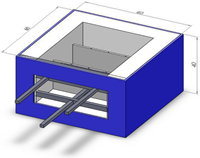Manufacture and Design an Apparatus for Measuring the Thermal Resistance of Building Materials
DOI:
https://doi.org/10.46604/peti.2022.9500Keywords:
thermal resistance, thermal conductivity coefficient, steady-state, absolute techniqueAbstract
A good thermal design of buildings plays a key role in reducing the thermal loads of heating and air conditioning systems and thus reducing energy consumption. This study develops a steady-state apparatus for measuring the thermal resistance of building materials by using an absolute technique. The apparatus is designed to accommodate the full and actual size of the tested samples of building materials used in the Syrian market to ease testing. Therefore, suitable samples do not have to be built for the apparatus; the thermal resistance is measured for many samples, and the results are compared with the thermal insulation code for buildings in the Syrian Arab Republic. The results show that the difference between the resistance values obtained from the experiments and the Syrian thermal insulation code is due to the materials used in the local markets and their non-compliance with the code. These materials need testing and quality control during the manufacturing process.
References
Y. A. Çengel, Heat Transfer: A Practical Approach, 2nd ed., New York: MacGraw-Hill, 2003.
F. P. Incropera, et al., Fundamentals of Heat and Mass Transfer, 6th ed., New York: John Wiley & Sons, 2007.
M. Kim, et al., “Numerical Case Study and Modeling for Spreading Thermal Resistance and Effective Thermal Conductivity for Flat Heat Pipe,” Case Studies in Thermal Engineering, vol. 31, Article no. 101803, March 2022.
M. Kim, et al., “Numerical Investigation and Modeling of Thermal Resistance and Effective Thermal Conductivity for Two-Phase Thermosyphon,” Case Studies in Thermal Engineering, vol. 27, Article no. 101358, October 2021.
J. H. Moon, et al., “Boiling-Driven, Wickless, and Orientation-Independent Thermal Ground Plane,” International Journal of Heat and Mass Transfer, vol. 167, Article no. 120817, March 2021.
D. Zhao, et al., “Measurement Techniques for Thermal Conductivity and Interfacial Thermal Conductance of Bulk and Thin Film Materials,” Journal of Electronic Packaging, vol. 138, no. 4, Article no. 040802, December 2016.
Standard Test Method for Steady-State Heat Flux Measurements and Thermal Transmission Properties by Means of the Guarded-Hot-Plate Apparatus, ASTM C177, 2019.
Standard Test Method for Thermal Conductivity of Solids by Means of the Guarded-Comparative-Longitudinal Heat Flow Technique, ASTM E1225, 2004.
Standard Test Method for Steady-State Heat Transfer Properties of Pipe Insulation, ASTM C335/C335M, 2017.
B. M. Zawilski, et al., “Description of the Parallel Thermal Conductance Technique for the Measurement of the Thermal Conductivity of Small Diameter Samples,” Review of Scientific Instruments, vol. 72, no. 3, pp. 1770-1774, March 2001.
O. Maldonado, “Pulse Method for Simultaneous Measurement of Electric Thermopower and Heat Conductivity at Low Temperatures,” Cryogenics, vol. 32, no. 10, pp. 908-912, April 1992.
Standard Test Method for Thermal Conductivity of Refractories by Hot Wire (Platinum Resistance Thermometer Technique), ASTM C1113/C1113M, 2009.
Standard Test Method for Measurement of Thermal Effusivity of Fabrics Using a Modified Transient Plane Source (MTPS) Instrument, ASTM D7984, 2016.
Standard Test Method for Thermal Diffusivity by the Flash Method, ASTM E1461, 2013.
M. M. Terzić, et al., “Development of a Single-Sided Guarded Hot Plate Apparatus for Thermal Conductivity Measurements,” Thermal Science, vol. 20, no. 1, pp. 321-329, 2016.
W. Hemminger, et al., “A Guarded Hot-Plate Apparatus for Thermal Conductivity Measurements over the Temperature Range -75 to 200 [°C],” International Journal of Thermophysics, vol. 6, no. 5, pp. 489-498, 1985.
U. Hammerschmidt, “Guarded Hot-Plate (GHP) Method: Uncertainty Assessment,” International Journal of Thermophysics, vol. 23, no. 6, pp. 1551-1570, 2002.
M. Łach, et al., “Development and Characterization of Thermal Insulation Geopolymer Foams Based on Fly Ash,” Proceedings of Engineering and Technology Innovation, vol. 16, pp. 23-29, August 2020.
“Arduino Uno R3,” http://www.arduino.cc, June 2022.
“Cold-Junction-Compensated K-Thermocoupleto-Digital Converter (0°C to +1024°C),” http://www.maximintegrated.com, June 2021.
Thermal Insulation Code for Buildings in the Syrian Arab Republic, Syrian Engineers Association, 2006.

Published
How to Cite
Issue
Section
License
Submission of a manuscript implies: that the work described has not been published before that it is not under consideration for publication elsewhere; that if and when the manuscript is accepted for publication. Authors can retain copyright of their article with no restrictions. Also, author can post the final, peer-reviewed manuscript version (postprint) to any repository or website.

Since Oct. 01, 2015, PETI will publish new articles with Creative Commons Attribution Non-Commercial License, under The Creative Commons Attribution Non-Commercial 4.0 International (CC BY-NC 4.0) License.
The Creative Commons Attribution Non-Commercial (CC-BY-NC) License permits use, distribution and reproduction in any medium, provided the original work is properly cited and is not used for commercial purposes







